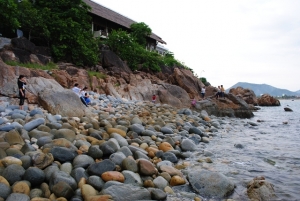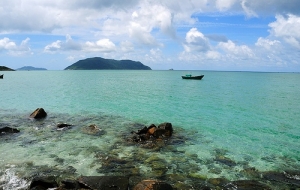Peaceful beachs in Quy Nhon
Tourists can take a flight or a train from HCMC to Quy Nhon. The first destination tourists should head to is Ghenh Rang tourist site 2km away from Quy Nhon City. The site is close to Xuan Van Mountain and was formed from continuous winding stone banks and caves. The way leading to Ghenh Rang is beautifully built on a slightly sloping path.
Standing in Ghenh Rang, tourists can experience a panoramic view of Quy Nhon. A highlight of the site is Hoang Hau (Queen) Beach that looks like a beautiful hidden fairy. The name “queen” came from a historical fact that the late emperor of Vietnam, Bao Dai and his wife, Queen Nam Phuong chose this place as a private relaxation place during their trip in 1927.

Quy Hoa beach
From Hoang Hau Beach, tourists can drive about 2km to get to Quy Hoa Beach where an old center with over 200 houses in French style for leprosy patients is located. The peaceful beach with pure water under poplar shades and chirping sound of birds mingled in the wave sounds. The place is where late poet Han Mac Tu spent his last days and created many popular poems. Other attractions at the site include a statue park to acknowledge contribution of scientists and those who have helped cure the leprosy.
Tourists can drive about 8km to the countryside of Quy Nhon to discover about ten popular beaches, including bai Chinh, bai Bau, bai Dai, bai Dai, and bai Nhon Ly among others. Especially, Xep Beach is popular for a fruit garden and coconut garden nearby.
During weekends, tourists also flock to Bang Beach to swim, relax and go fishing. There are thatch-roofed huts on the beach at the price of VND40,000 per hour for tourists to relax.

Banh beo
Quy Nhon has many specialties at cheap prices, including banh beo (cake made from rice powder served with dried shrimp), and bun cha ca (fish paste noodles) on Nguyen Hue Street, or seafood and Vietnamese-style pancake on Le Hong Phong Street.
Stunning beauty of Bay Canh Islet
Con Dao Island, about 97 nautical miles from Vung Tau City, is seen as a pearl of Viet Nam’s sea tourism and renowned for its fascinating sceneries and tasty seafood specialties.
As the second largest among 16 islands in Con Dao, Bay Canh stands out as a tropical ecological reserve with a mangrove forest and peaceful beaches.

Turles lay eggs at nighttime
To the island, tourists are advised not to miss Cat Lon Beach, which is home to various sea turtles that often lay eggs at nighttime. Moreover, tourists can also visit an old lighthouse built in 1884 to take a close look at French colonial architecture and a panoramic view of the island.

Bay Canh lighthouse
Protected as a nature reserve, the mangrove forest on the island still has plenty of rare fauna. Therefore, a trip to the island is worthwhile for those who want to escape from urban noise and get lost in nature’s beauty and fresh air.
Source: SGT







































































































